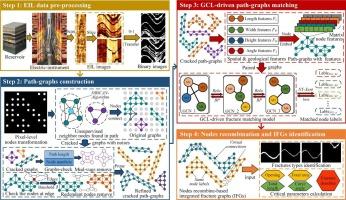确保裂缝性储层中的二氧化碳储存:关键天然裂缝路径的智能表征
IF 7.5
1区 工程技术
Q2 ENERGY & FUELS
引用次数: 0
摘要
在碳捕集、利用与封存(CCUS)部署过程中,准确表征枯竭油藏天然裂缝(NF)对于降低二氧化碳泄漏风险至关重要。然而,传统方法无法解决在电成像测井(EIL)图像中可靠分割破碎裂缝网络的核心挑战,导致存储完整性评估存在很大的不确定性。为了克服这一限制,我们提出了一种融合先验知识引导图表示和图对比学习的新型双核智能框架。具体来说,NF特征是通过显式编码空间属性(例如,裂缝密度,方位角)的像素节点转换路径图提取的,然后是基于知识的多阈值去噪以消除非导电伪影。至关重要的是,引入了一个图对比学习模型来分析断裂节点之间的形态依赖关系,从而在细微变化下实现碎片段的鲁棒匹配,这是传统机器学习方法无法实现的能力。通过中国西南地区的现场数据验证,该方法在裂缝识别方面的突破精度达到96.37%,明显优于现有技术。该研究为从碎片化的EIL图像中重建完整的NF网络提供了可扩展的解决方案,为关键的CO2泄漏途径提供了可靠的表征。通过确保可靠的水库潜力评估,我们的方法直接提高了存储安全性,并推进了可再生能源转型倡议中碳封存的安全部署。本文章由计算机程序翻译,如有差异,请以英文原文为准。

Securing CO2 storage in fractured reservoirs: Intelligent characterization of critical natural fracture pathways
Accurate characterization of natural fractures (NF) in depleted reservoirs is critical for mitigating CO2 leakage risks during Carbon Capture, Utilization and Storage (CCUS) deployment. However, conventional methods fail to address the core challenge of reliably segmenting fragmented fracture networks in Electrical Imaging Logging (EIL) images, leading to significant uncertainties in storage integrity assessment. To overcome this limitation, we propose a novel dual-core intelligent framework integrating prior knowledge-guided graph representation and graph contrastive learning. Specifically, NF features are extracted via pixel-node transformed path-graphs that explicitly encode spatial attributes (e.g., fracture density, azimuth), followed by knowledge-based multi-threshold denoising to eliminate non-conductive artifacts. Crucially, a graph contrastive learning model is introduced to analyze morphological dependencies among fracture nodes, enabling robust matching of fragmented segments under subtle variations—a capability unattainable by traditional machine learning methods. Validated with field data from Southwest China, our approach achieves a breakthrough accuracy of 96.37% in fracture identification, significantly outperforming existing techniques. This study contributes the scalable solution for reconstructing complete NF networks from fragmented EIL images, providing reliable characterization of critical CO2 leakage pathways. By ensuring reliable reservoir potential assessment, our method directly enhances storage security and advances the safe deployment of carbon sequestration in renewable energy transition initiatives.
求助全文
通过发布文献求助,成功后即可免费获取论文全文。
去求助
来源期刊

Fuel
工程技术-工程:化工
CiteScore
12.80
自引率
20.30%
发文量
3506
审稿时长
64 days
期刊介绍:
The exploration of energy sources remains a critical matter of study. For the past nine decades, fuel has consistently held the forefront in primary research efforts within the field of energy science. This area of investigation encompasses a wide range of subjects, with a particular emphasis on emerging concerns like environmental factors and pollution.
 求助内容:
求助内容: 应助结果提醒方式:
应助结果提醒方式:


